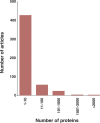Plasma Proteome Database as a resource for proteomics research: 2014 update
- PMID: 24304897
- PMCID: PMC3965042
- DOI: 10.1093/nar/gkt1251
Plasma Proteome Database as a resource for proteomics research: 2014 update
Abstract
Plasma Proteome Database (PPD; http://www.plasmaproteomedatabase.org/) was initially described in the year 2005 as a part of Human Proteome Organization's (HUPO's) pilot initiative on Human Plasma Proteome Project. Since then, improvements in proteomic technologies and increased throughput have led to identification of a large number of novel plasma proteins. To keep up with this increase in data, we have significantly enriched the proteomic information in PPD. This database currently contains information on 10,546 proteins detected in serum/plasma of which 3784 have been reported in two or more studies. The latest version of the database also incorporates mass spectrometry-derived data including experimentally verified proteotypic peptides used for multiple reaction monitoring assays. Other novel features include published plasma/serum concentrations for 1278 proteins along with a separate category of plasma-derived extracellular vesicle proteins. As plasma proteins have become a major thrust in the field of biomarkers, we have enabled a batch-based query designated Plasma Proteome Explorer, which will permit the users in screening a list of proteins or peptides against known plasma proteins to assess novelty of their data set. We believe that PPD will facilitate both clinical and basic research by serving as a comprehensive reference of plasma proteins in humans and accelerate biomarker discovery and translation efforts.
Figures


References
-
- Anderson NL, Anderson NG. The human plasma proteome: history, character, and diagnostic prospects. Mol. Cell Proteomics. 2002;1:845–867. - PubMed
-
- Zhang H, Liu AY, Loriaux P, Wollscheid B, Zhou Y, Watts JD, Aebersold R. Mass spectrometric detection of tissue proteins in plasma. Mol. Cell Proteomics. 2007;6:64–71. - PubMed
-
- Tirumalai RS, Chan KC, Prieto DA, Issaq HJ, Conrads TP, Veenstra TD. Characterization of the low molecular weight human serum proteome. Mol. Cell Proteomics. 2003;2:1096–1103. - PubMed
-
- Ping P, Vondriska TM, Creighton CJ, Gandhi TK, Yang Z, Menon R, Kwon MS, Cho SY, Drwal G, Kellmann M, et al. A functional annotation of subproteomes in human plasma. Proteomics. 2005;5:3506–3519. - PubMed
-
- Yang Z, Hancock WS, Chew TR, Bonilla L. A study of glycoproteins in human serum and plasma reference standards (HUPO) using multilectin affinity chromatography coupled with RPLC-MS/MS. Proteomics. 2005;5:3353–3366. - PubMed
Publication types
MeSH terms
Substances
Grants and funding
LinkOut - more resources
Full Text Sources
Other Literature Sources
Research Materials

